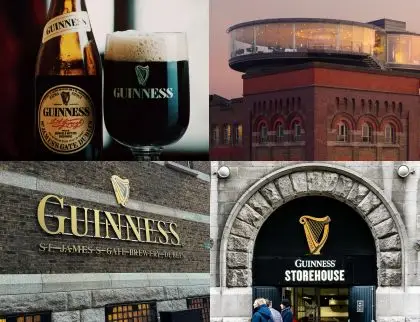A Pint of Inspiration: Guinness Marketing Tactics for Life Science Brands
Written by:
Date:

If you’ve ever planned a trip to Dublin, you’ve likely been advised to make a trip to the Guinness Storehouse – and for good reason. I recently traveled to Ireland for a strategic planning session with one of our long-time clients based in Dublin – but first thing’s first: a requisite stop at St. James’s Gate Brewery, founded in Dublin by Arthur Guinness in 1759, and home to the Guinness Brewery. As a life scientist by training, I found the deep dive into the unique science of Guinness beer brewing completely fascinating. But, what really surprised me was how much I learned about the brand’s incredible advertising history, which began in 1929 with its first official slogan: “Guinness is Good for You.”
Trust your brand to build trust
The “good for you” slogan was the cornerstone of Guinness marketing for 40 years. Surely one would think four decades is an obscenely long time to repeat the same five words over and over in your advertising. But, as our CEO, Dillon Allie, is always saying to our clients: “You’re going to get sick of it a lot faster than your audience will.” And he’s right. Studies have shown that people need to see a message, on average, at least seven times1 before they pay attention, and even more before they remember it. Repetition creates a sense of familiarity, which ultimately breeds trust – the more acquainted people are with a brand, the more likely they are to buy from that brand.
But, of course, all of this falls flat if the message you’re putting out there is missing a strong brand platform – in other words, an overarching set of values, principles and ideas that shape the identity of a company. The reason “Guinness is Good For You” works so well is because it is the perfect representation of the plain-language, jovial persona that the Guinness brand embodies.
Relatable narratives resonate
It should come as no surprise that the most impactful ads are those that tell a story – narrative ads. And the most impactful narrative ads are those that are relatable. In fact, decades of research has proven that people are more likely to be influenced by stories in which they can imagine themselves.2,3,4 By incorporating characters, scenarios, and feelings to which people can relate, campaigns can cultivate a sense of familiarity between the brand and the audience, and ultimately foster positive brand attitudes. This approach, sometimes called “empathetic storytelling,” drives brand awareness by presenting target audiences with relatable situations they may have experienced themselves.
Guinness was an early pioneer in analyzing consumer consumption habits in an effort to know with whom, exactly, they were trying to empathize. After conducting buyer research in the 1960s, Guinness deviated from its typical advertising approach of playful, illustrated print ads by producing a TV ad featuring a man drinking a Guinness at the end of his work day – a scene that would clearly resonate with its identified target audience. The “Guinness at the end of the day” ad was ingenious because not only did it have all of the elements of a sophisticated narrative ad5 and strategically incorporate the company’s target customer, but it also maintained the unpretentious tone that is true to the Guinness brand.
Another stroke of Guinness genius was the company’s “welcome back” ad, which launched in May 2021, just after pubs reopened following the COVID-19 lockdown. The ad begins with vivid depictions of the loneliness we all experienced during the extended periods of isolation, and ends with a communal celebration of pubs and bars around the world reopening their doors to friends and families who can finally gather together and share a long-missed pint of Guinness. The ad is an emotional story that would resonate with nearly anyone watching.
Don’t put all of your eggs in one basket
In addition to TV commercials, the “welcome back” ad was shared via social media, print, programmatic, and digital out-of-home. Guinness even started an accompanying hashtag – #LooksLikeGuinness – for people to use when posting pictures of their post-lockdown pints on social media. But this multifaceted campaign playbook was neither new nor unique for the Guinness marketing team. The company takes media diversity so seriously that it has developed an in-house marketing mix modeling system, called Catalyst, to ensure each of its campaigns is strategically distributed across a multitude of channels. The company feels the interaction effects of media distributed across several channels will always outperform a single-channel approach. And this holds true for life sciences brands as well. Our VP of Media, John Pantlind, is continuously telling our clients: “You need to meet your audience where they are,” and not everyone we’re trying to reach is always in the same place at the same time. When it comes to media, more is more – as long as the story you’re telling across channels remains authentic.
Lessons for life science brands
So, fellow scientists, let’s recap some marketing lessons we can learn from the masters at Guinness:
- Don’t change course just because you’re sick of seeing the same headline or creative or asset over and over. Your audience needs to see these things over and over to establish connection. So, if the campaign is not only successful in terms of performance, but also in terms of reflecting the brand persona you’ve established, then: Stick. With. It.
- The best ads convey stories to which your audience can relate. For life science brands, this can be a bit complicated because we almost always need to speak to multiple audiences. But that’s okay. That’s why we develop creative briefs that answer the following questions: Who are our primary audiences? Our secondary audiences? What do they believe? What do we want them to believe? What do we need to show each of these audiences to make them say: “Yes. That company gets it.”
- You can’t rely on one tactic or one channel to successfully reach your target audience. We all consume our information in different ways and in different places. Some clinicians might love webinars, others might prefer the sparknotes version in an email. We want attention from both. Therefore, why not use both channels to convey our message?
So, while the title of this blog may have had you questioning why we would care about a beer company’s marketing, hopefully you can now agree that, not only is a pint of Guinness always refreshing and never stale, the same can be said for the company’s marketing strategy.
References
- Lant, J. L. (1998). Money making marketing: Finding the people who need what you’re selling and making sure they buy it. JLA Publications.
- Green, M. C., & Brock, T. C. (2000). The role of transportation in the persuasiveness of public narratives. Journal of Personality and Social Psychology, 79(5), 701–721. https://doi.org/10.1037//0022-3514.79.5.701
- Murphy, S. T., Frank, L. B., Chatterjee, J. S., & Baezconde-Garbanati, L. (2013). Narrative versus nonnarrative: The role of identification, transportation, and emotion in reducing health disparities. Journal of Communication, 63(1), 116–137. https://doi.org/10.1111/jcom.12007
- de Graaf, A., Hoeken, H., Sanders, J., & Beentjes, J. W. (2011). Identification as a mechanism of narrative persuasion. Communication Research, 39(6), 802–823. https://doi.org/10.1177/0093650211408594
- Kim, E., Ratneshwar, S., & Thorson, E. (2017). Why narrative ads work: An integrated process explanation. Journal of Advertising, 46(2), 283–296. http://doi.org/10.1080/00913367.2016. 1268984
You may also like
All rights reserved Privacy Policy






